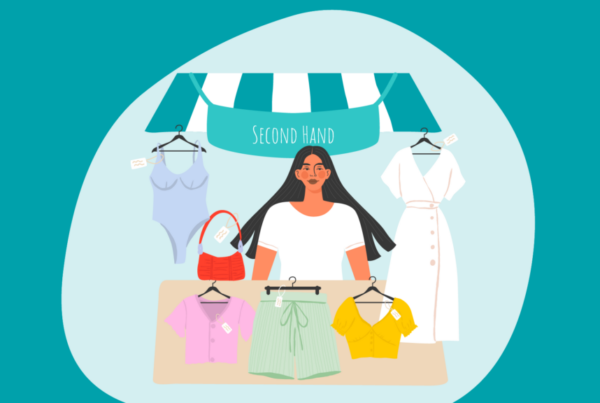Fashion is a rapidly evolving field, but in recent years, an important trend has emerged: eco-responsibility. More and more brands and consumers are becoming aware of the environmental impact of the fashion industry and are seeking ways to make their choices more sustainable. We will explore the various strategies that brands are adopting to integrate eco-responsibility into their practices and the sustainable trends shaping the future of fashion.

Material Choices: Promoting Durability
In the context of eco-responsible fashion, the use of sustainable materials is a cornerstone for reducing the environmental impact of the textile industry. Sustainable materials are those that are grown, harvested, or manufactured in a way that minimizes their impact on the environment throughout their life cycle, from production to end of life.
- Organic Cotton: Organic cotton is grown without the use of chemical pesticides or synthetic fertilizers, which significantly reduces the environmental impact of its production. Organic farming practices also promote soil biodiversity and reduce water pollution.
- Linen: Linen is an extremely durable natural fiber that requires little water for its cultivation and generally does not require the use of pesticides. Additionally, linen is biodegradable, meaning it decomposes naturally at the end of its life without leaving harmful residues.
- Recycled Polyester: Recycled polyester is made from recycled plastic bottles and other plastic waste, thus reducing reliance on virgin resources and contributing to the reduction of plastic waste in oceans and landfills.
- Upcycling: A trend among designers for several years, upcycling allows for the recycling of already used textiles to give them a second life. Consumers are increasingly inclined to purchase such creations as each piece is unique.
By choosing these sustainable materials, fashion brands can not only reduce their carbon footprint and water consumption but also promote more environmentally friendly agricultural and manufacturing practices. Moreover, these materials often offer advantages in terms of quality, durability, and comfort for environmentally conscious consumers, thereby enhancing their appeal in the eco-responsible fashion market.
Adopting Responsible Manufacturing Processes
Adopting responsible manufacturing processes is a crucial step in reducing the environmental footprint of the fashion industry. Brands are increasingly seeking to minimize their environmental impact at every stage of production, from design to manufacturing.
Use of Eco-Friendly Dyes and Treatments: The dyes and chemical treatments used in clothing manufacturing can have a harmful impact on the environment and human health. Brands are adopting eco-friendly, water-based dyes and treatments that reduce water pollution and eliminate the use of toxic chemicals.
Water Conservation: Clothing production often requires large amounts of water for washing, rinsing, and treating fabrics. Brands are implementing water management systems to reduce their water consumption and reuse water whenever possible, thereby contributing to the conservation of water resources.
Use of Renewable Energy: To reduce their carbon footprint, many brands are investing in the use of renewable energy sources such as solar and wind power to power their manufacturing facilities. This helps to reduce greenhouse gas emissions associated with clothing production.
Sustainable Transport and Logistics: Brands are also seeking to reduce the carbon footprint of their supply chain by optimizing transport modes and promoting sustainable logistics practices, such as consolidating shipments and using low-emission transportation methods.
By adopting these responsible manufacturing processes, fashion brands can significantly reduce their environmental impact while ensuring the quality and integrity of their products. These practices also help meet the growing consumer expectations for sustainability, thereby enhancing the reputation and competitiveness of brands in the eco-responsible fashion market.
Promoting Transparency and Ethics
In a world where consumers are increasingly aware of the impact of their choices, transparency and ethics are becoming crucial elements in the fashion industry. Brands that commit to disclosing information about their production practices and ensuring fair and safe working conditions for workers are increasingly appreciated by ethically-conscious consumers.

- Supply Chain Transparency: Ethical brands are increasingly transparent about the origins of their products, providing detailed information about their supply chain, from the source of raw materials to manufacturing and distribution of finished products. This transparency allows consumers to make informed decisions and support responsible practices.
- Ethical and Sustainable Certifications: Certifications such as Fair Trade, GOTS (Global Organic Textile Standard), and B Corp attest to a brand’s commitment to ethical and sustainable practices. Certified brands are required to adhere to strict standards regarding working conditions, fair wages, environmental protection, and social responsibility, which offers additional assurance to ethically-conscious consumers.
- Supporting Local Communities: Ethical brands also strive to support the local communities in which they operate by investing in economic development, education, and health programs. By contributing to the well-being of local communities, these brands reinforce their positive social impact and build lasting relationships with their stakeholders.
By highlighting transparency and ethics in their practices, fashion brands can inspire consumer trust and establish strong, lasting relationships with their audience. Furthermore, by promoting fair working conditions and supporting local communities, these brands help create a positive impact on both the environment and the people involved in their supply chain.
Sustainable Trends in Fashion
In the world of sustainable fashion, the adoption of emerging trends plays a central role in reducing returns and increasing conversion. Trends such as minimalism, slow fashion, and upcycling redefine how consumers perceive and consume fashion. Meanwhile, sizing recommendation tools like Fitle help personalize the shopping experience, thereby reducing sizing errors and related returns.
Sustainable trends like minimalism encourage consumers to prioritize quality over quantity, thus promoting more thoughtful and sustainable purchases. Slow fashion, in turn, emphasizes the ethical and responsible manufacturing of clothing, encouraging brands to adopt sustainable production practices and offer timeless products. Finally, upcycling transforms waste into new creations, providing a creative alternative to disposable fashion.
In this context, sizing recommendation tools play a crucial role by offering a practical solution to reduce returns related to sizing issues. By using sizing technologies and morphological data, these tools can recommend the most suitable size for each individual, thereby reducing sizing errors and related returns. By integrating tools like Fitle into their online sales strategy, brands can not only improve the customer experience and reduce returns but also contribute to promoting more responsible and sustainable consumption in the fashion industry.
In conclusion, integrating sustainable practices and using sizing recommendation tools in the fashion industry represents significant advances toward a more responsible and ethical future. By adopting sustainable trends and offering personalized solutions to consumers, brands can reduce their environmental impact while enhancing the customer experience and encouraging more thoughtful consumption. Together, these initiatives contribute to creating a more conscious and respectful fashion industry, meeting consumer needs while preserving the planet for future generations.




